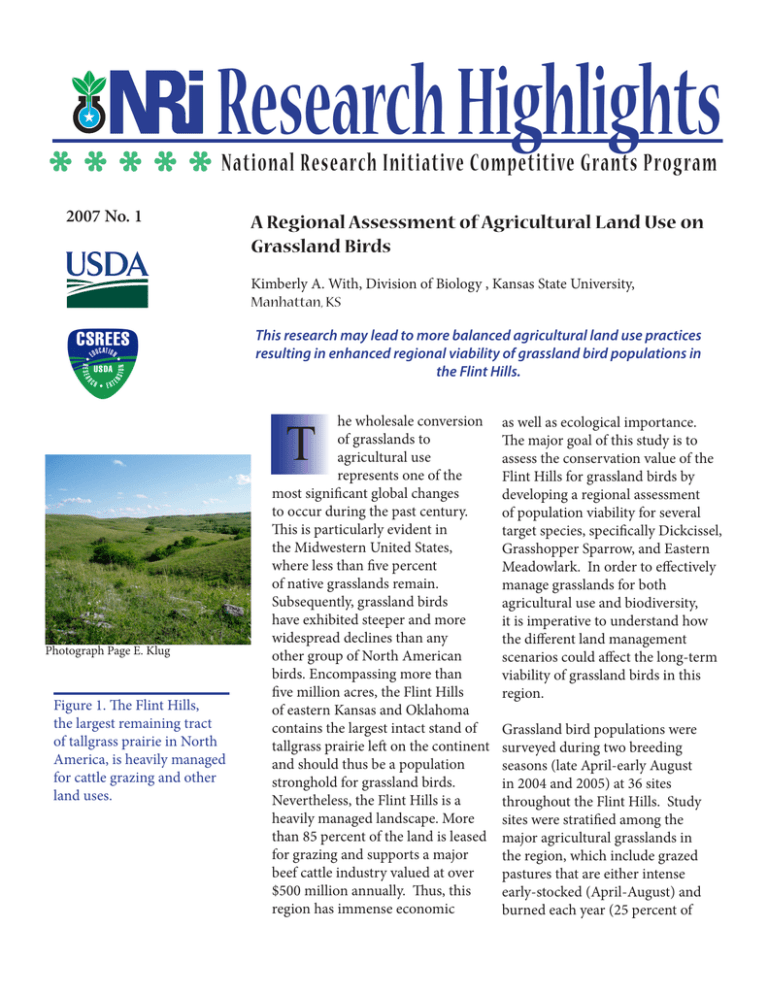Research Highlights A Regional Assessment of Agricultural Land Use on Grassland Birds
advertisement

Research Highlights National Research Initiative Competitive Grants Program 2007 No. 1 A Regional Assessment of Agricultural Land Use on Grassland Birds Kimberly A. With, Division of Biology , Kansas State University, Manhattan, KS This research may lead to more balanced agricultural land use practices resulting in enhanced regional viability of grassland bird populations in the Flint Hills. T Photograph Page E. Klug Figure 1. The Flint Hills, the largest remaining tract of tallgrass prairie in North America, is heavily managed for cattle grazing and other land uses. he wholesale conversion of grasslands to agricultural use represents one of the most significant global changes to occur during the past century. This is particularly evident in the Midwestern United States, where less than five percent of native grasslands remain. Subsequently, grassland birds have exhibited steeper and more widespread declines than any other group of North American birds. Encompassing more than five million acres, the Flint Hills of eastern Kansas and Oklahoma contains the largest intact stand of tallgrass prairie left on the continent and should thus be a population stronghold for grassland birds. Nevertheless, the Flint Hills is a heavily managed landscape. More than 85 percent of the land is leased for grazing and supports a major beef cattle industry valued at over $500 million annually. Thus, this region has immense economic as well as ecological importance. The major goal of this study is to assess the conservation value of the Flint Hills for grassland birds by developing a regional assessment of population viability for several target species, specifically Dickcissel, Grasshopper Sparrow, and Eastern Meadowlark. In order to effectively manage grasslands for both agricultural use and biodiversity, it is imperative to understand how the different land management scenarios could affect the long-term viability of grassland birds in this region. Grassland bird populations were surveyed during two breeding seasons (late April-early August in 2004 and 2005) at 36 sites throughout the Flint Hills. Study sites were stratified among the major agricultural grasslands in the region, which include grazed pastures that are either intense early-stocked (April-August) and burned each year (25 percent of Photograph David A. Rintoul Figure 2. Grasshopper Sparrow (Ammodramus savannarum) with katydid. reproductive success were used to estimated seasonal fecundity, an important population vital rate in demographic models that estimate population growth rates within these different management types. Ultimately, these estimates were integrated across the landuse mosaic of the Flint Hills to determine the likelihood that these species are viable across the entire region. The broad regional scope of this project represents one of the most ambitious population viability analyses ever conducted. Demographic analysis revealed that grassland management affects the managed grasslands in the Flint Hills), or season-long stocked grassland bird productivity in the Flint Hills in different ways. (April-November), which may be At a local scale, Grasshopper burned (40 percent) or unburned (26 percent) in a given year. Other Sparrow and Eastern Meadowlark had the highest productivity in study sites included native hay burned hayfields, while Dickcissel pastures (usually mowed in midproductivity was highest in July), which may be burned (2 unburned hayfields. Grasslands percent) or unburned (5 percent) that year, and Conservation Reserve restored under the CRP were only used by Dickcissels, but these fields Program fields, which may be ultimately did not support locally burned (1 percent) or unburned viable populations of this species. (2 percent) in a given year. Each Thus, CRP is less important for site was searched every 3-5 days grassland birds in the context for active nests and to monitor whether young successfully fledged of native prairie rangeland than it is elsewhere in the Midwest. or were lost to predation. Data on The research reported in this fact sheet was sponsored by the Managed Ecosystems Program of the National Research Initiative Competitive Grants Program. To be placed on the mailing list for this publication or to receive additional information, please contact the NRI (202-401-5022 or NRICGP@csrees.usda. gov). The fact sheet also is accessible via the NRI section of the Cooperative State Research, Education, and Extension Service Web site (http://www.csrees. usda.gov/nri). Any findings, conclusions, or opinions expressed by individuals in this research report are those of the authors and do not necessarily represent the policies of the U.S. Department of Agriculture. Publication of this fact sheet does not imply recommendation or endorsement by USDA over other research reports not mentioned. January 2007 More critically, however, all three species appear to be exhibiting substantial declines across the region. Dickcissels are projected to decline by 20-29 percent/year. Similarly, Grasshopper Sparrows are projected to decline by 1627 percent/year and Eastern Meadowlarks by 12-24 percent/year. Despite being the largest remaining grassland of its kind, the Flint Hills does not currently support viable populations of these native birds. Figure 3. Black kingsnake depredating grasshopper sparrow nest. Predation is the leading cause of nest failure in grassland birds. Photograph Corina J. Rahmig The U.S. Department of Agriculture (USDA), including CSREES, prohibits discrimination in all its programs and activities on the basis of race, color, national origin, age, disability, and where applicable, sex, marital status, familial status, parental status, religion, sexual orientation, genetic information, political beliefs, reprisal, or because all or a part of an individual’s income is derived from any public assistance program. (Not all prohibited bases apply to all programs.) Persons with disabilities who require alternative means for communication of program information (Braille, large print, audiotape, etc.) should contact USDA’s TARGET Center at (202) 720-2600 (voice and TDD). To file a complaint of discrimination write to USDA, Director, Office of Civil Rights, 1400 Independence Avenue, S.W., Washington, D.C. 20250-9410 or call (800) 795-3272 (voice) or (202) 720-6382 (TDD). USDA is an equal opportunity provider and employer. For more information on civil rights and equal opportunity policies and programs, visit the CSREES Equal Opportunity Office.




